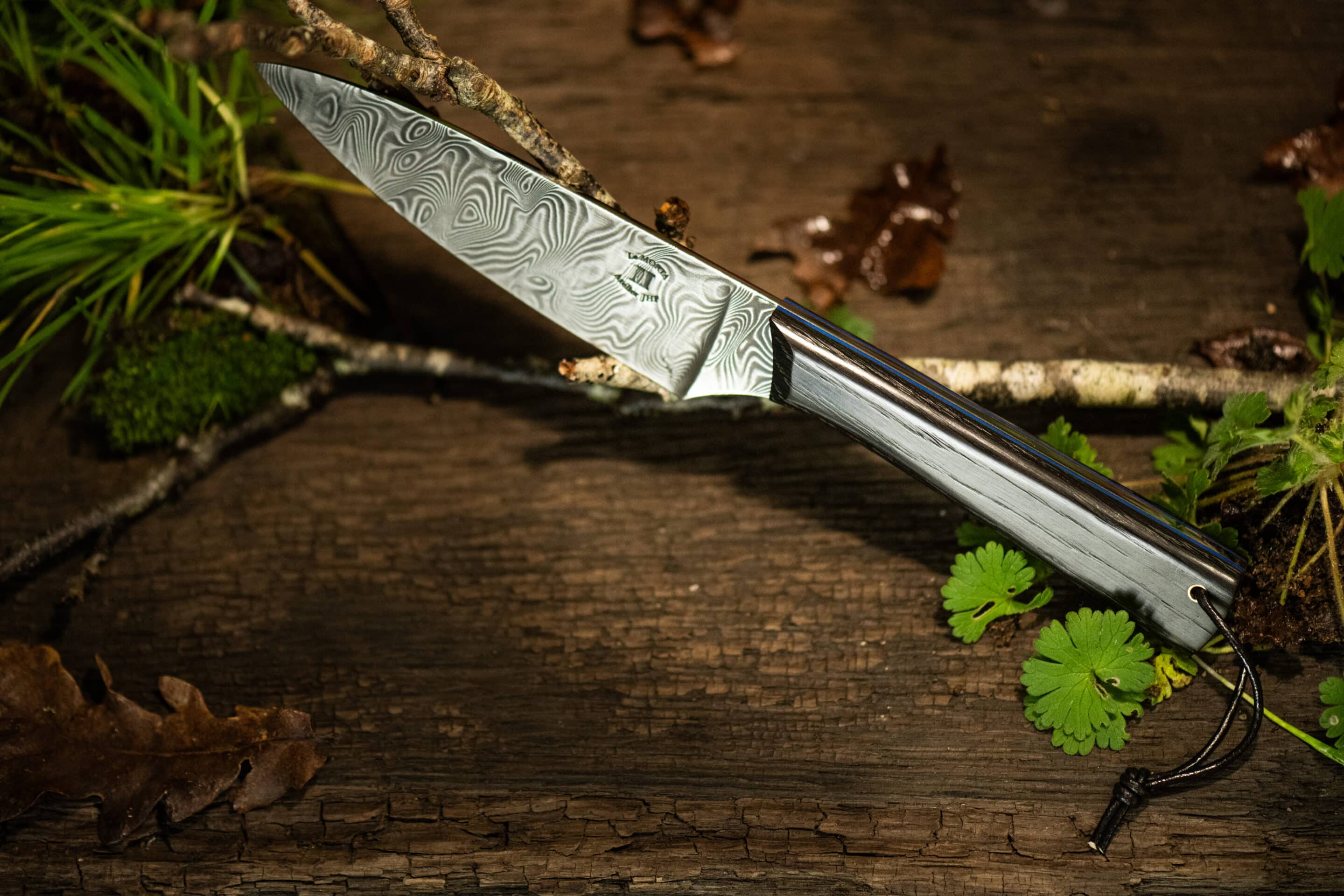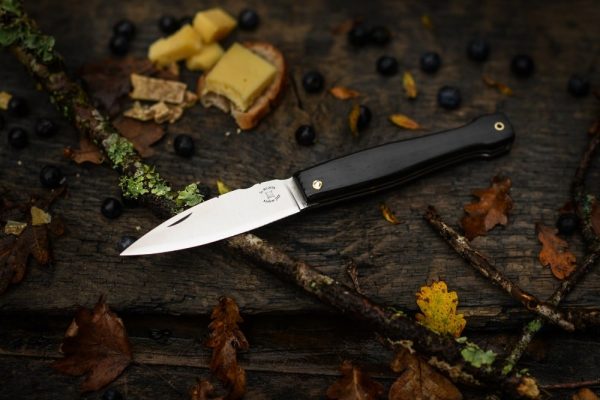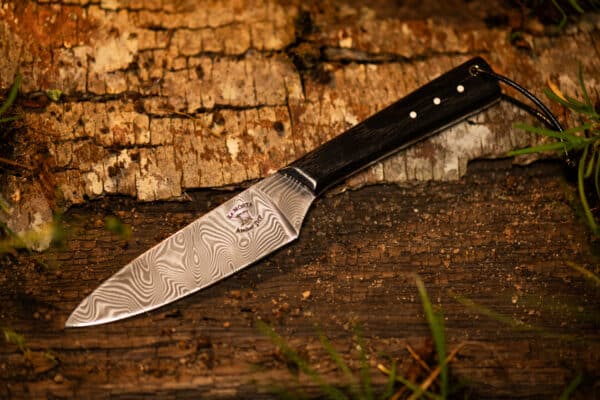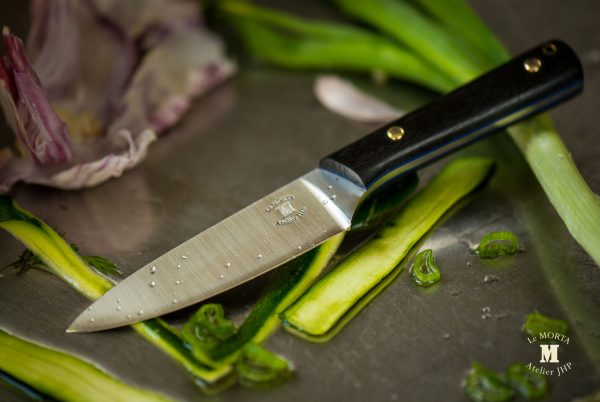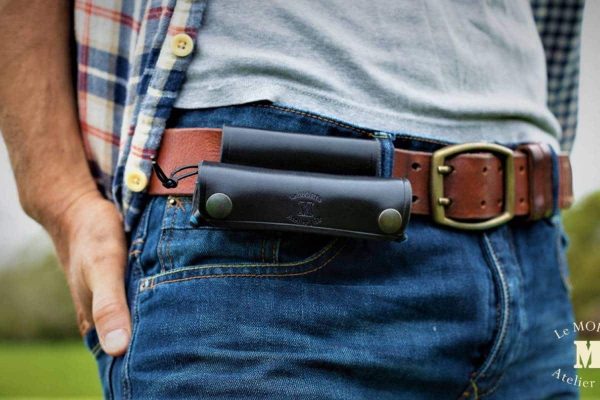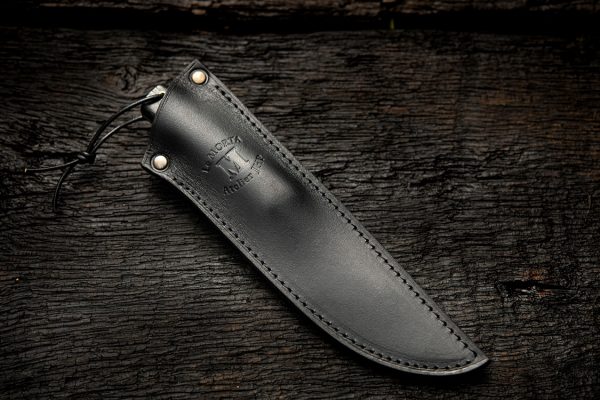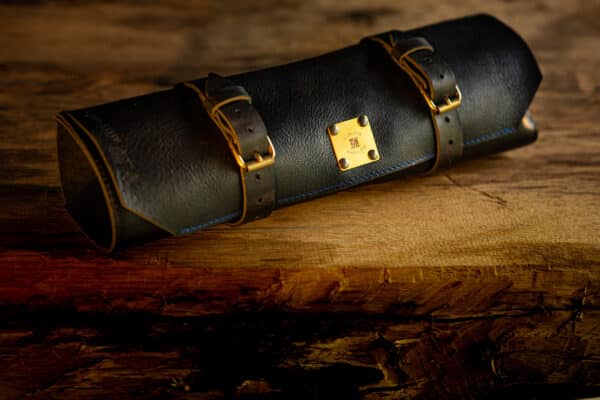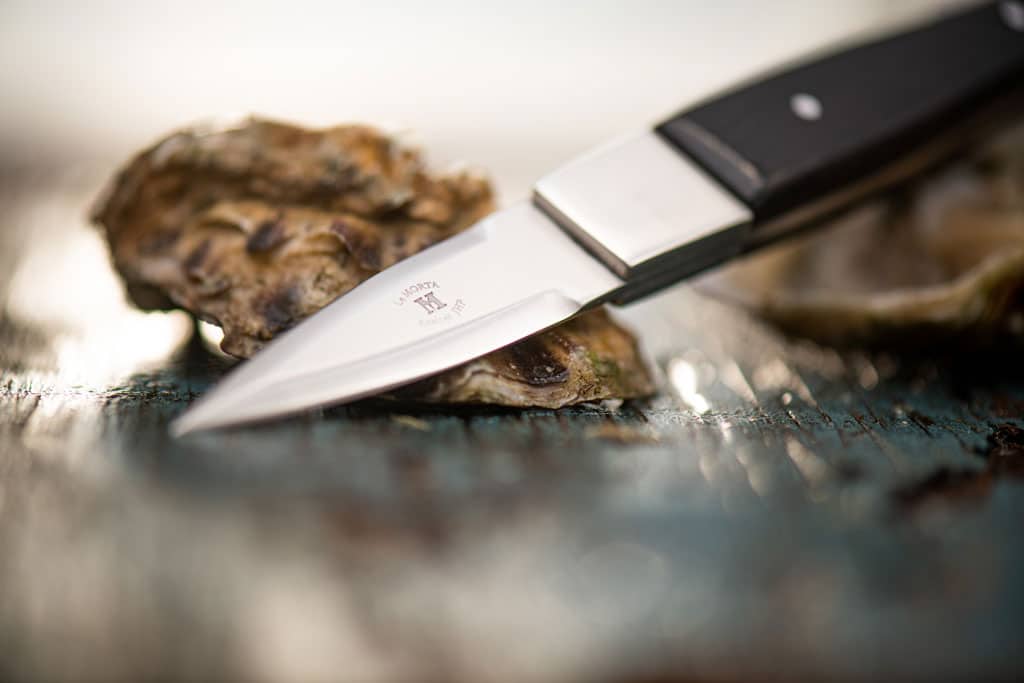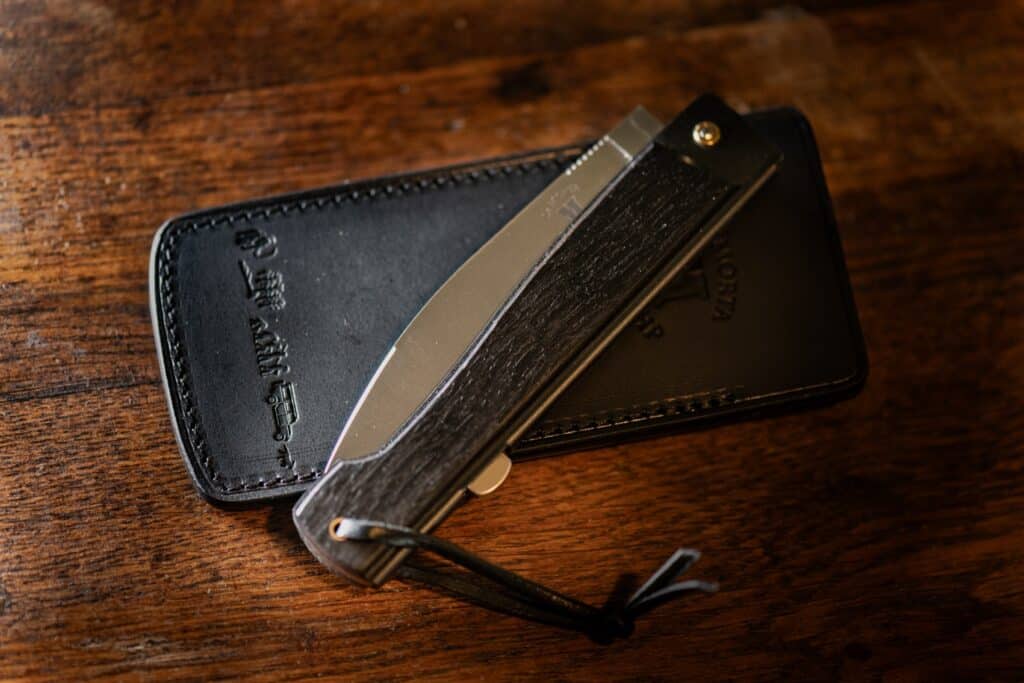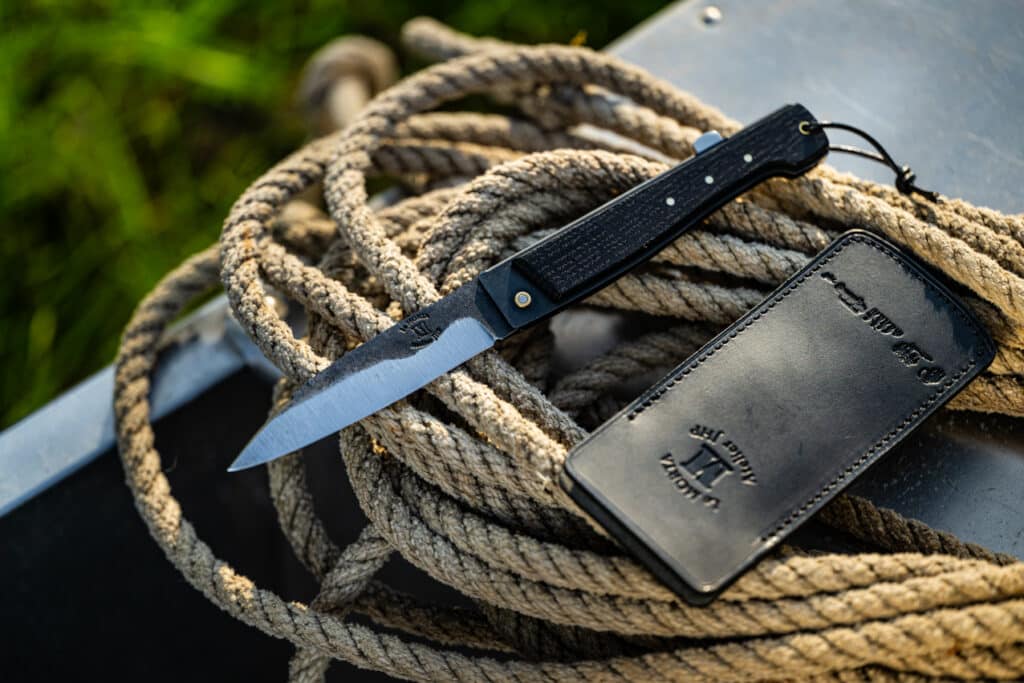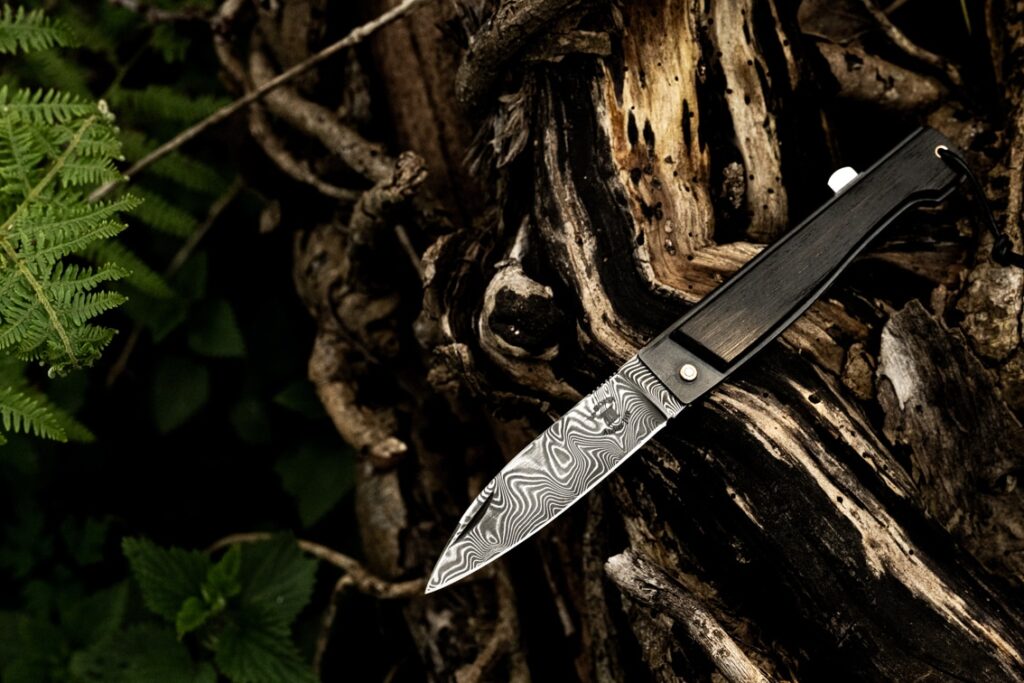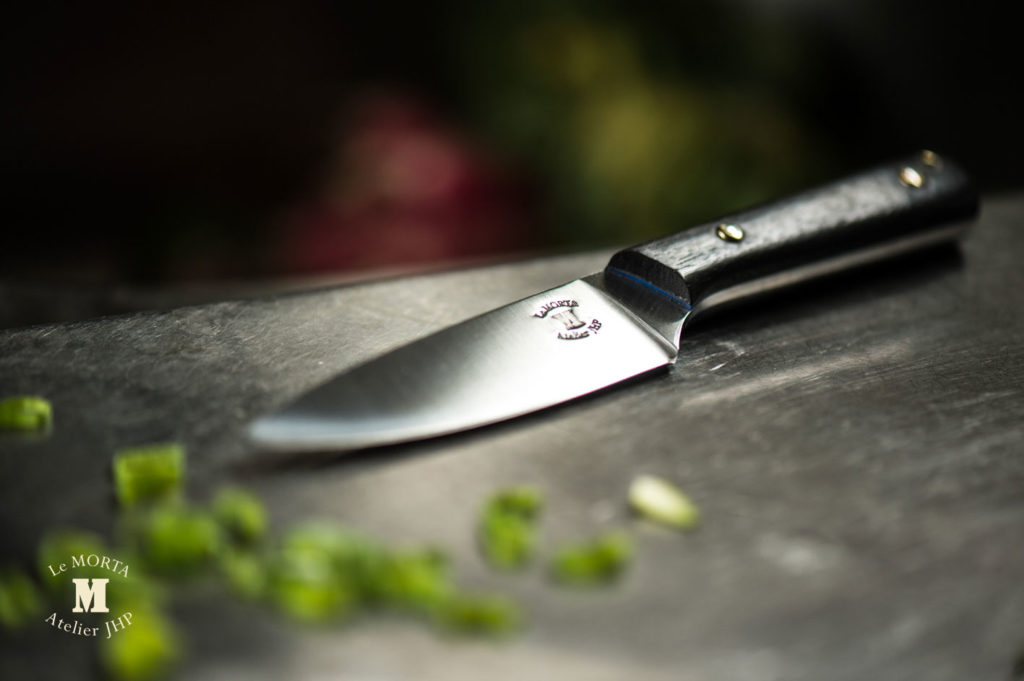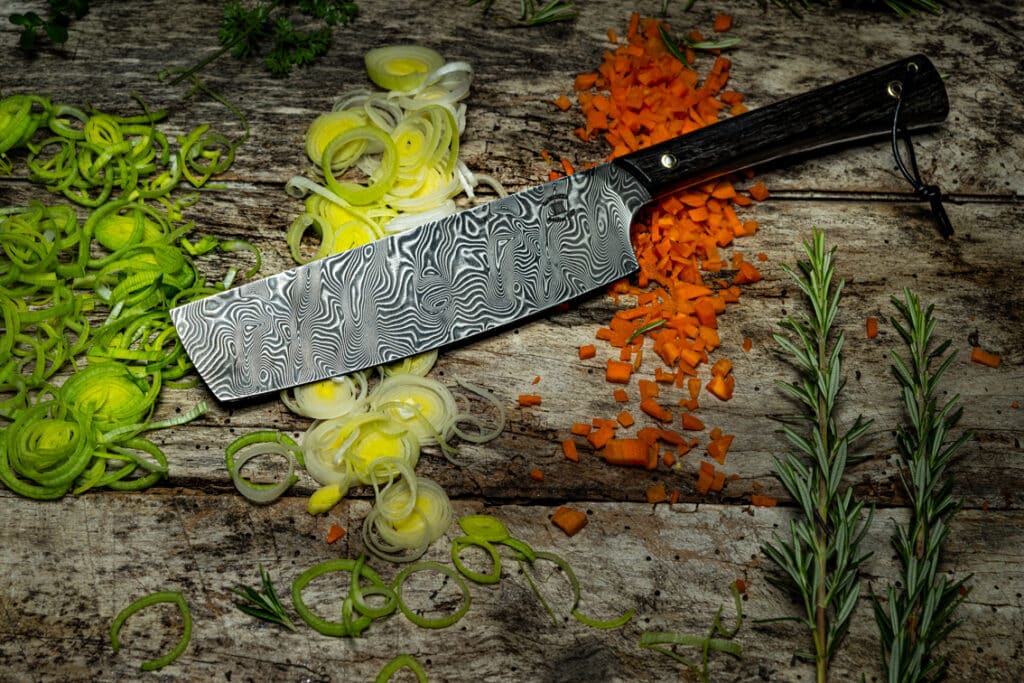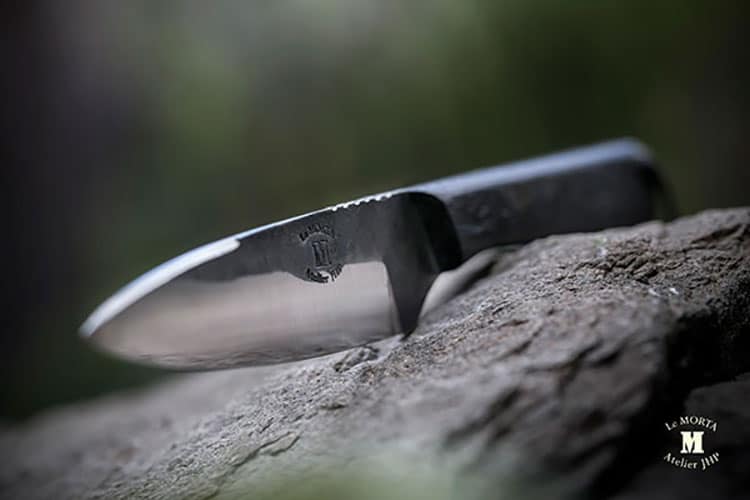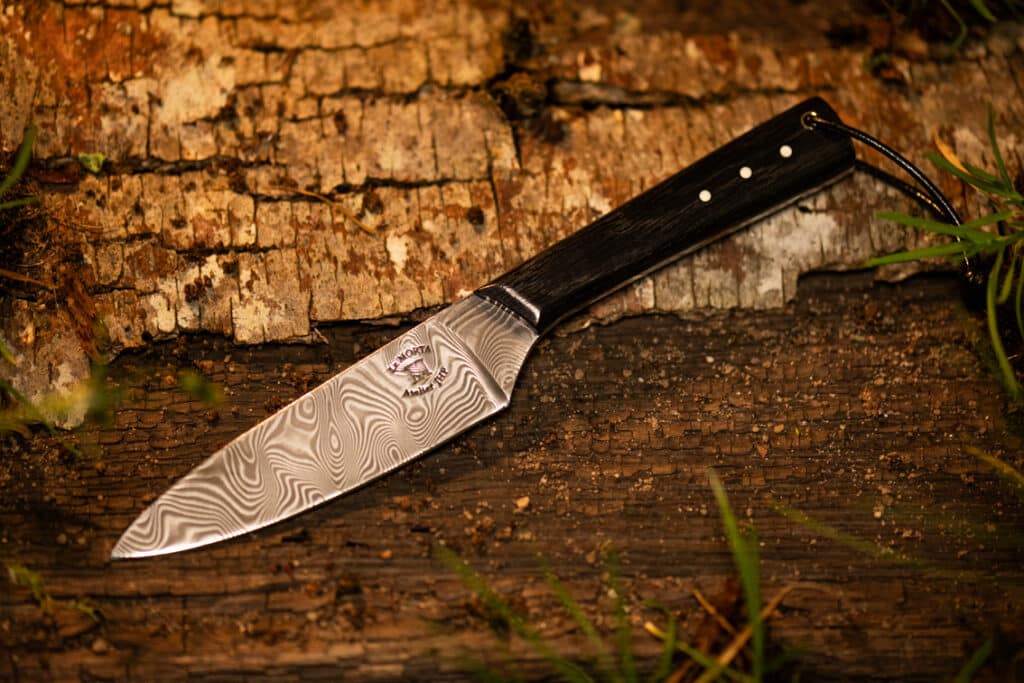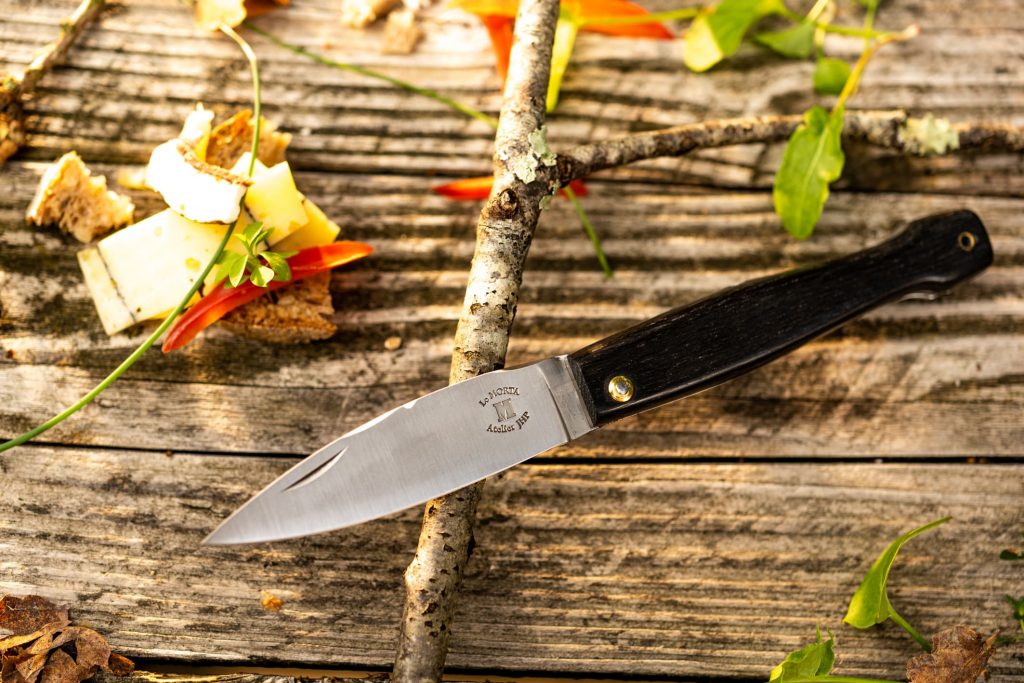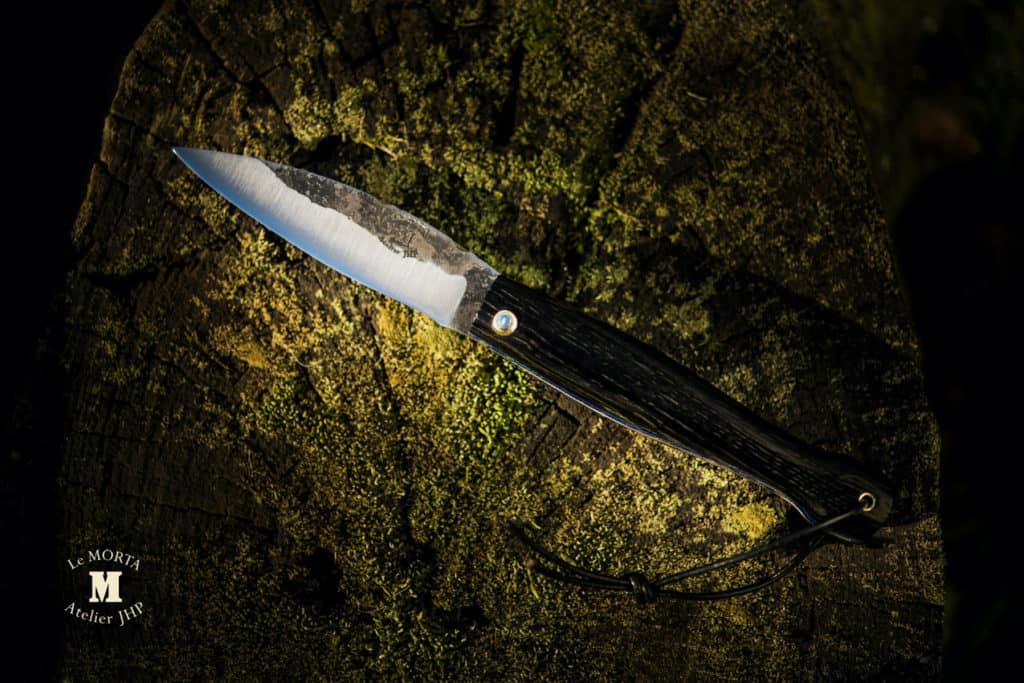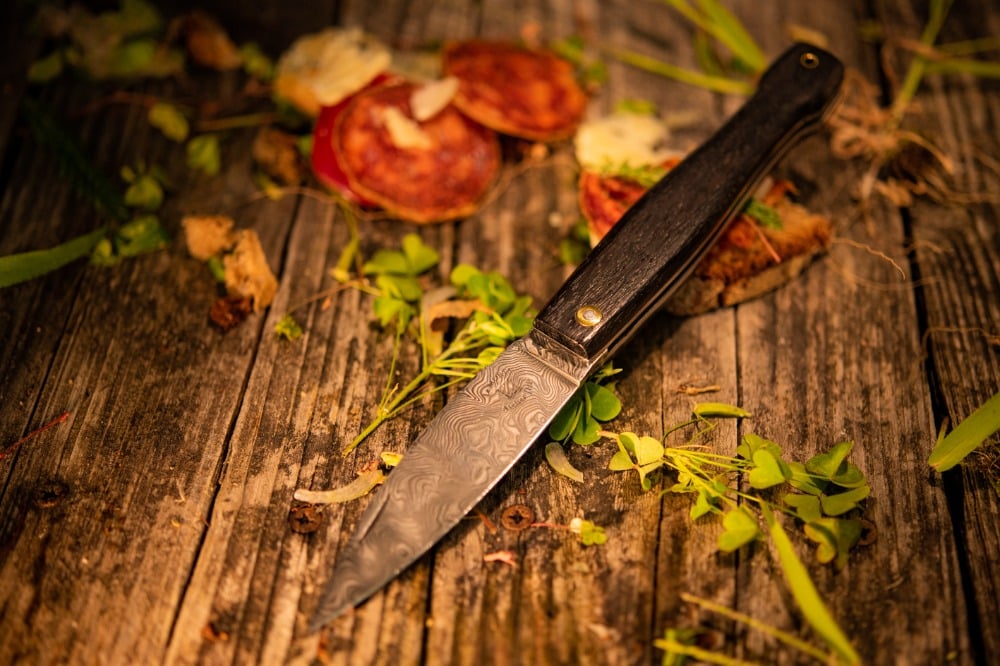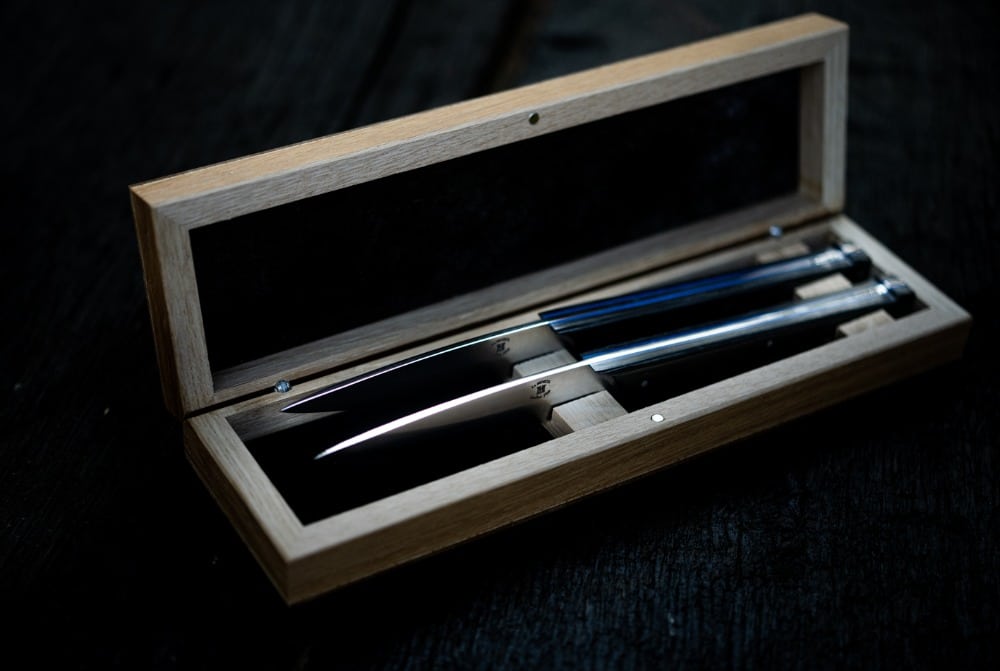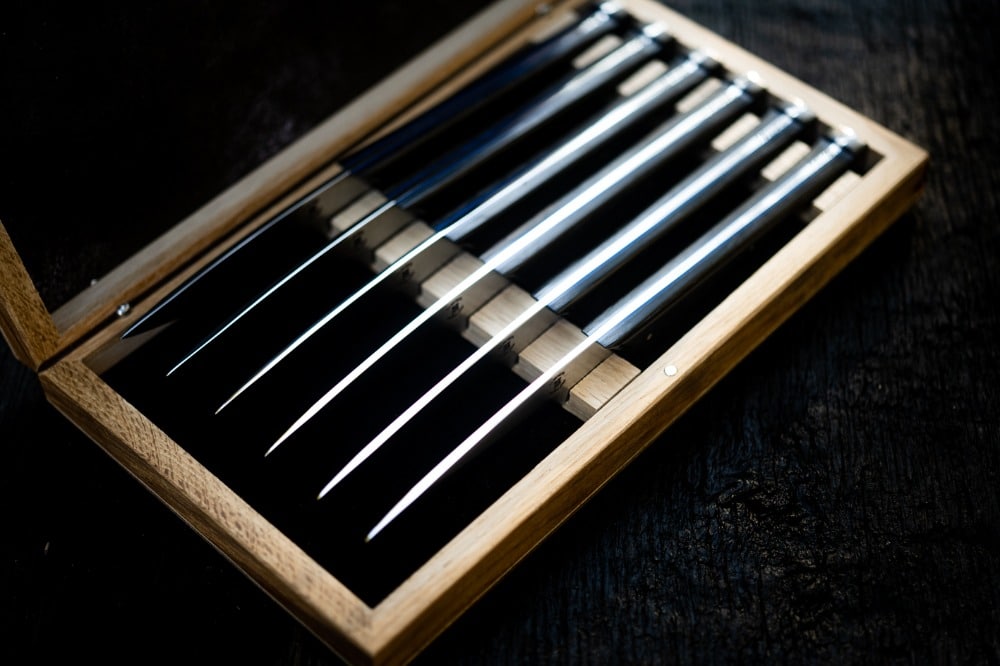Taking care of your business? So do we! Like your oak furniture or teak decking, your wooden knife handle deserves your attention. Wood is a noble material that warms interiors and stands the test of time. Whether exotic or local, each tree brings its own personal and identifiable touch. Knives are distinguished by their blade (forged steel, Damascus), their use (paring, pocket or kitchen knife) and also by their handle. Good care of the handle of your wooden knife guarantees its durability and the permanence of its natural lustre. But above all, delicate care of the material ensures a perfect patina in the palm of your hand.
At Morta Knives, we swear by the latter, but here is a complete care guide for the handle of your favorite knife. Discovering oils.
Why care for your knife handle?
Taking care of your knife means ensuring its efficiency, durability and safety.
Environmental factors (humidity, cold, heat) as well as shocks and the wear of time alter wood.
Poor handle care can lead to :
- deformation ;
- cracking ;
- loss of shine ;
- drying out;
- a less comfortable grip;
- aesthetic deterioration.
Care for wooden handles
Wood is a hygroscopic material, absorbing or releasing moisture according to its humidity level.
Even when fossilized, it remains sensitive to water. So avoid putting your wooden knife handle under the tap or, worse still, in the dishwasher. This is especially true for folding knives, whose mechanism could rust if the steel used is not stainless.
Generally speaking, quality wood does not get wet. The knifemaker takes the necessary care when making and finishing the knife.
Exotic woods such as Ambony, Teak or Royal Ebony, like regional woods, do not appreciate water. Oil and a clean cloth are preferable.
Arizona ironwood, like pakkawood , does not require oil treatment. Like all stabilized (resin-impregnated) woods, it just requires wiping.
🔪 Morta is a wood in the process of fossilization. As our readers know, it has remained buried in damp soil for thousands of years. Now, understandably, it’s longing for a dry world!
A wood in the process of fossilization, you say?
-

XL Solid Morta
180,00 € This product has multiple variants. The options may be chosen on the product page -

Compact fixed damascus knife
340,00 € This product has multiple variants. The options may be chosen on the product page -

XL Paring knife
180,00 € This product has multiple variants. The options may be chosen on the product page
Organic handles
In the cutlery trade, many knives have handles made from organic materials: horn, deer antler, mammoth or warthog ivory.
Here again, avoid water, as they may swell and split.
Store them in a dry place, at room temperature, away from sources of heat and strong light. Minimal care is required with these materials. They are intended for everyday use provided they do not come into contact with water.
🔪 Knifemaker’s tip: wrapping your knife in tissue paper protects it from moisture.
The benefits of oil for maintaining a wooden knife handle
A noble, living material (or one in the process of fossilization 😉), wood requires simple, but regular, gentle care. Otherwise, it dries out, grays and denatures. Its color, an essential element of its charm, loses its brilliance.
This is because wood is made up of lignins and polysaccharides that degrade under the effect of UV rays and water. However, losing its shine does not affect the structure of the wood itself.
Why treat wood with oil?
Treating a knife handle with vegetable oil offers a number of advantages, not least durability.
- Oil protects against humidity, delaying the penetration of water into the wood thanks to its hydrophobic properties. Non-film-forming, it acts by impregnation and therefore does not create a surface film (unlike varnish).
- It moisturizes and prevents drying.
- It enhances wood’s natural color by acting as a barrier against solar radiation. It enhances the wood’s radiance, respects its original color and enhances its grain.
- It stabilizes wood, preventing it from swelling, warping and cracking.
- It reduces or even eliminates stains and rings that may appear on a poorly maintained knife handle.
- It regulates temperature variations. Your folding knife will be with you at dawn for your walks, at the peak of the sun for your midday picnic and at dusk in front of the campfire. So you can go from hot to cold and vice versa. Don’t worry, he doesn’t mind slicing a fresh lemon followed by a rare rib-eye steak. On the contrary, he loves it!
- It avoids scratches and other wear and tear of time: friction, vibrations, shocks, etc.
🔪 Vegetable oil doesn’t prevent wood from developing a patina, much to the delight of knife lovers who like to feel the handle hugging the shape of their palm.
💡 Worth knowing: Painted or lacquered wood cannot be oiled.
Mineral oil or vegetable oil?
A timely environmental question.
Mineral oil is a fatty substance derived from petroleum, in the same way as kerosene, for example. Its fossil fuel origin makes it less popular.
Vegetable oil is a fatty substance extracted from an oleaginous plant (flax, rapeseed, almond, apricot, hemp, coconut, shea, hazelnut, olive, juniper, macadamia, grape seed, etc.). It therefore comes from a renewable source. It is mixed with a solvent for faster drying.
🔪 Some knife brands offer care balms or wood waxes. At Couteaux Morta, we recommend beeswax.
How to care for your wooden handle Our best advice
The expert opinion of Couteaux Morta
First and foremost, you have to love your knife. Yes, you read that right. That object you never leave home, that penknife you received from your grandfather or your child.
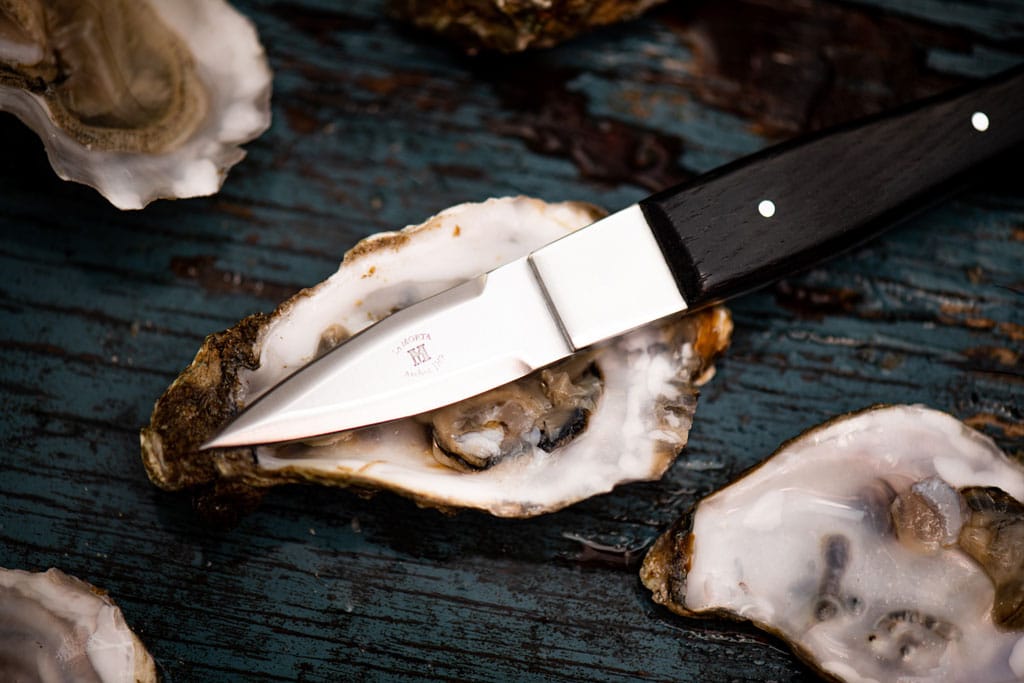
In the morning, it slices bread, at lunchtime, it brightens up a frugal meal during a quick break, and in the evening…
Ah, in the evening, it reconciles sausage, cheese and oysters over a well-deserved aperitif. So, yes, we take good care of it. Store it away from moisture and light (and away from curious, unscrupulous fingers).
Just wipe the blade with a damp cloth.
Just pay special attention to the mechanism if your knife is folding. Dirt clings to it. And when it comes to food, hygiene is no joke.
Maintenance steps
From time to time, you can give it a little beauty treatment with oil or beeswax. There’s nothing complicated about it.
- Clean your blade with a damp cloth and dry. Clear water is all you need. If necessary (but really if necessary) add a drop of washing-up liquid. Be careful not to use corrosive products.
- Apply a few drops (a very thin layer) of oil or beeswax to the handle with a soft, clean cloth.
- Allow the oil to absorb for about 15 minutes.
- Wipe the handle and remove the excess.
- Rub gently with a dry cloth to remove all traces of stubborn oil.
- Repeat the operation until the wood is saturated, i.e. until the oil no longer penetrates.
- A soft cloth is all you need for perfect polishing. You may also use a wood wax.
That’s all there is to it!
🔪 A soft, dry cloth is all you need to maintain your Morta knife handle.
In a marine environment, the salty air makes it all the more important to store your knife carefully in a drawer, sheath, case or bag if you’re lucky enough to own several.
-

Case for folding knife
45,00 € This product has multiple variants. The options may be chosen on the product page -

Sheath for folding knife
45,00 € This product has multiple variants. The options may be chosen on the product page -

Sheaths for fixed knives
45,00 € This product has multiple variants. The options may be chosen on the product page -

Knives Storage Roll
125,00 € This product has multiple variants. The options may be chosen on the product page
Oils for wooden knife handles
Camellia oil
Camellia oil comes from the Camellia sinensis plant and is extracted by cold pressing.
Ultra-fluid, it penetrates wood easily. It protects against humidity, dust and light. It prevents rust, blade oxidation and handle dryness. Nourishes and softens wood.
It highlights the wood’s natural grain. Knife lovers love it, as it maintains both the wooden handle and the blade.
It’s ideal for kitchen and paring knives with 90mcv8 carbon steel blades, for example.
Linseed oil
Obtained from ripe pressed linseed, linseed oil nourishes and protects wood against moisture, fungi and insects.
It gives a golden sheen. It darkens or yellows light woods. Morta, already almost ebony, tolerates it well. It can even enhance its honey- or caramel-colored highlights.
Please note that this oil is not recommended for exotic woods, as it changes their color too much.
On the other hand, it is perfectly suited to all other types of wood.
Linseed oil has anti-rust properties, making it ideal for knives. You maintain the wooden handle and apply a thin layer to the blade to protect it from corrosion.
Its odor, a little strong on application, fades as it dries.
Baked linseed oil dries more quickly. It is said to be siccative, as contact with air accelerates drying. Raw linseed oil (rich in fatty acid triglycerides) has the advantage of not having undergone any heat treatment.
Linseed oil can be combined with turpentine or walnut stain.
⚠️ Warning: fabric soaked in linseed oil becomes flammable in air. Remember to wash it or store it in an airtight box.
Olive oil
Olive oil removes stains and streaks from wooden surfaces. It’s best mixed with vinegar and a little salt.
Disadvantage: it can leave a rancid odor on the knife.
Wouldn’t it be better suited to seasoning a homemade green pesto made with wild edible plants? Yes, yes, it’s possible… 😉
Danish oil
Danish oil is actually a blend of natural oils and resins that restores the wood’s lustre. It leaves a satin finish. It can be applied to all types of wood and takes between 4 and 6 hours to dry.
We recommend polishing the wood after using Danish oil to avoid lacquer formation.
Food-safe, it is used to maintain kitchen utensils. Knife handles and blades can be treated with Danish oil.
Tung oil
Derived from the tung nut, it is better known in cabinetmaking as Chinese wood oil. It leaves no discoloration on your wood. It is mainly used for parquet flooring, as it protects against intensive use.
It is said to be “hard” because of its siccative nature (accelerated drying) and stiffening.
😉 Use it to clean your cutting board.
Teak oil
A confusing misnomer. Teak oil is, in fact, a vegetable oil for teak: the light exotic wood used outdoors.
As you’ll have gathered, at Morta Knives we’re not fans of over-treatment to maintain your wooden knife handles. That said, Morta is a special wood. In the process of fossilization, it deserves special care: the same care you give to everything you hold dear.
Article summary
Why is it important to treat the wooden handle of a knife?
Treating the wooden handle of a knife ensures its durability, efficiency and user safety.
In addition, environmental factors such as humidity, cold and heat, as well as shocks and the wear of time, can alter wood.
Poor maintenance can cause the handle to warp, crack, lose its shine and dry out, making it less comfortable to hold and detracting from its aesthetic appeal.
How do I care for a wooden knife handle?
The first thing to know about maintaining a wooden knife handle is that you should avoid running it under running water or in the dishwasher at all costs. This is all the more important for folding knives, whose mechanism could rust.
Instead, we recommend using a vegetable oil, such as linseed oil or beeswax, and a clean cloth. Here are the steps to follow:
- Clean the handle with a damp cloth and dry well.
- Apply a few drops of oil or beeswax to the handle with a soft, clean cloth.
- Allow the oil to absorb for about 15 minutes.
- Wipe off any excess oil.
- Rub gently with a dry cloth to remove any residual oil.
- Repeat the operation until the wood is saturated, i.e. until the oil no longer penetrates.
Which oils are recommended for maintaining wooden knife handles?
Several vegetable oils are recommended for the care of wooden knife handles, each with its own specific properties:
- Camellia oil: ultra-fluid, it protects against humidity, dust and light. It prevents rust, blade oxidation and handle dryness. Ideal for kitchen knives.
- Linseed oil: nourishes and protects wood against moisture, fungi and insects. It gives a golden sheen and is well suited to most wood species except exotic woods.
- Tung oil: derived from the tung nut, it is renowned for its ability to protect wood from intensive use and leaves no discoloration.
- Teak oil: although the name may be misleading, this is a vegetable oil used to protect exotic woods such as teak.
Why should I avoid using water to clean a wooden knife handle?
Wood is a hygroscopic material, which means it absorbs moisture. This can lead to swelling, cracking and deformation of the handle.
What’s more, water can cause the mechanism of folding knives to rust if the steel is not stainless. A simple wipe with a damp cloth is all it takes to clean the blade.
What's the difference between mineral oil and vegetable oil for wood handle care?
Mineral oil is derived from petroleum, like kerosene, and is less popular because of its fossil origin.
Vegetable oil, extracted from oleaginous plants such as linseed, rapeseed or almond, comes from renewable sources and is mixed with a solvent for faster drying.
Vegetable oils are preferred for their ability to nourish and protect wood in a natural, environmentally-friendly way.
What are the advantages of treating knife handles with vegetable oil?
Treating your knife handle with vegetable oil offers several advantages:
- The oil retards the penetration of water into the wood.
- It prevents the wood from drying out.
- It enhances the wood’s natural color and grain, while acting as a barrier against UV rays.
- It prevents wood from swelling, warping or cracking.
- Oil helps remove and prevent stains and rings.
- It helps wood resist temperature variations.
What are the specific care recommendations for horn handles?
Horn handles, as well as those made from deer antler or mammoth ivory, require special care to preserve their integrity and aesthetics.
Here are a few recommendations:
- Keep horn handles in a dry environment at room temperature.
- Like wood, horn is sensitive to water, which can cause it to swell and crack. Avoid direct contact with water. Clean the handle with a slightly damp cloth and dry immediately.
- Protect horn handles from direct heat and intense light, which can dry out and weaken the material.
- Although horn requires less maintenance than wood, a light rubbing with a cloth soaked in mineral or vegetable oil (such as camellia oil) can help maintain its shine and suppleness.
- If possible, wrap your knife in tissue paper to protect it from moisture and scratches when not in use.
What types of wood require special treatment for knife handles?
Wood in the process of fossilization, such as Morta, requires special care. This wood spent thousands of years buried in damp soil and now longs for a dry environment.
It’s important to protect it from excessive humidity and to apply a regular oil treatment to preserve its ecology.
What are the specific care recommendations for horn handles?
Horn handles, as well as those made from deer antler or mammoth ivory, require special care to preserve their integrity and aesthetics.
Here are some general tips for the care of wooden knives:
- Never put knives in the dishwasher.
- Use a soft, clean cloth to clean and apply oil.
- Store knives in a dry place, away from humidity and direct light.
- Apply oil regularly to keep the wood moisturized and protected.
- Take care of folding-knife mechanisms to prevent rust and damage.


